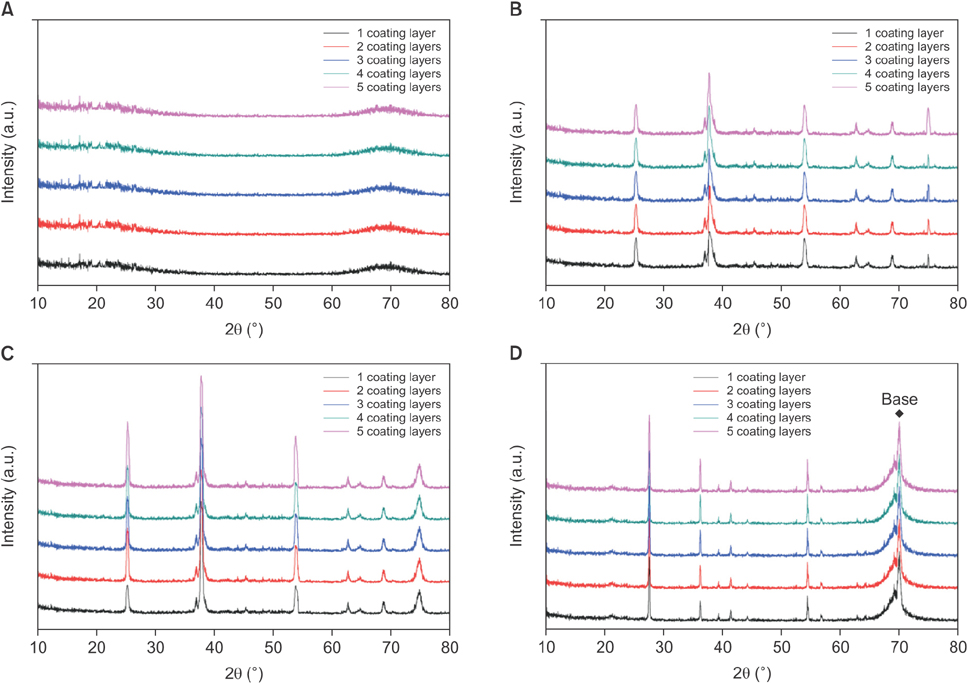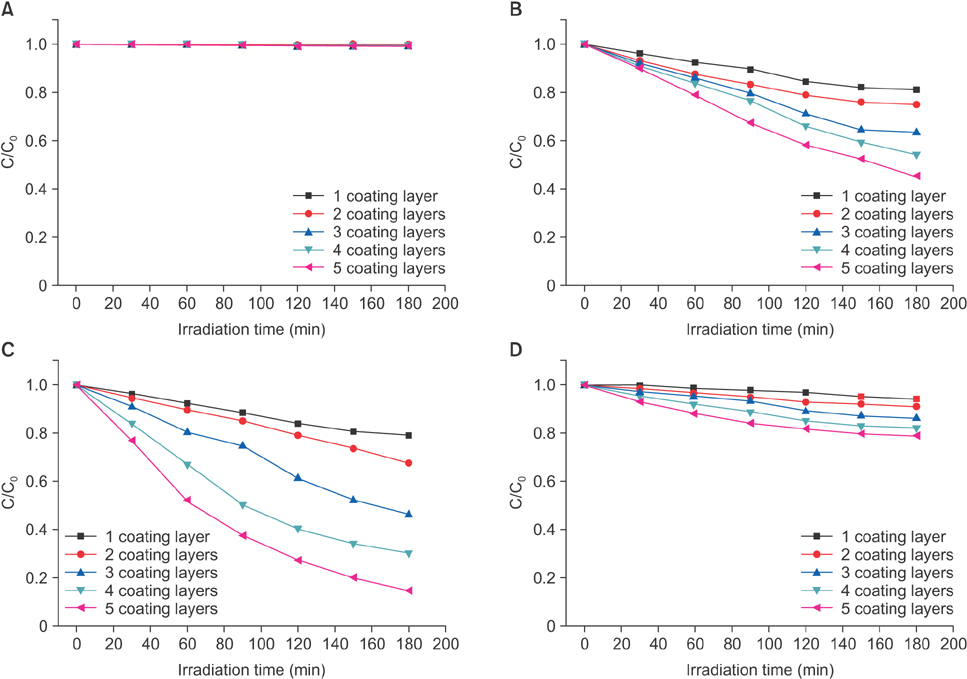Korean J Orthod.
2016 May;46(3):146-154. 10.4041/kjod.2016.46.3.146.
Preparation and antimicrobial assay of ceramic brackets coated with TiO2 thin films
- Affiliations
-
- 1Department of Orthodontics, School of Dentistry, Lanzhou University, Lanzhou, P. R. China. caobch@lzu.edu.cn
- 2Department of Physics, School of Physical Science and Technology, Lanzhou University, Lanzhou, P. R. China.
- KMID: 2164258
- DOI: http://doi.org/10.4041/kjod.2016.46.3.146
Abstract
OBJECTIVE
Different methods have been utilized to prevent enamel demineralization and other complications during orthodontic treatment. However, none of these methods can offer long-lasting and effective prevention of orthodontic complications or interventions after complications occur. Considering the photocatalytic effect of TiO2 on organic compounds, we hoped to synthesize a novel bracket with a TiO2 thin film to develop a photocatalytic antimicrobial effect.
METHODS
The sol-gel dip coating method was used to prepare TiO2 thin films on ceramic bracket surfaces. Twenty groups of samples were composed according to the experimental parameters. Crystalline structure and surface morphology were characterized by X-ray diffraction and scanning electron microscopy, respectively; film thickness was examined with a surface ellipsometer. The photocatalytic properties under ultraviolet (UV) light irradiation were analyzed by evaluating the degradation ratio of methylene blue (MB) at a certain time. Antibacterial activities of selected thin films were also tested against Lactobacillus acidophilus and Candida albicans.
RESULTS
Films with 5 coating layers annealed at 700℃ showed the greatest photocatalytic activity in terms of MB decomposition under UV light irradiation. TiO2 thin films with 5 coating layers annealed at 700℃ exhibited the greatest antimicrobial activity under UV-A light irradiation.
CONCLUSIONS
These results provide promising guidance in prevention of demineralization by increasing antimicrobial activities of film coated brackets.
MeSH Terms
Figure
Reference
-
1. Bishara SE, Fehr DE. Ceramic brackets: something old, something new, a review. Semin Orthod. 1997; 3:178–188.
Article2. Eliades T, Lekka M, Eliades G, Brantley WA. Surface characterization of ceramic brackets: a multitechnique approach. Am J Orthod Dentofacial Orthop. 1994; 105:10–18.
Article3. Eissaa OE, El-Shourbagy EM, Ghobashy SA. In vivo effect of a fluoride releasing adhesive on inhibition of enamel demineralization around orthodontic brackets. Tanta Dent J. 2013; 10:86–96.
Article4. Tufekci E, Dixon JS, Gunsolley JC, Lindauer SJ. Prevalence of white spot lesions during orthodontic treatment with fixed appliances. Angle Orthod. 2011; 81:206–210.
Article5. Richter AE, Arruda AO, Peters MC, Sohn W. Incidence of caries lesions among patients treated with comprehensive orthodontics. Am J Orthod Dentofacial Orthop. 2011; 139:657–664.
Article6. Gorelick L, Geiger AM, Gwinnett AJ. Incidence of white spot formation after bonding and banding. Am J Orthod. 1982; 81:93–98.
Article7. Chatterjee R, Kleinberg I. Effect of orthodontic band placement on the chemical composition of human incisor tooth plaque. Arch Oral Biol. 1979; 24:97–100.
Article8. Øgaard B. White spot lesions during orthodontic treatment: mechanisms and fluoride preventive aspects. Semin Orthod. 2008; 14:183–193.
Article9. Scheie AA, Arneberg P, Krogstad O. Effect of orthodontic treatment on prevalence of Streptococcus mutans in plaque and saliva. Scand J Dent Res. 1984; 92:211–217.
Article10. Mattsson A, Lejon C, Bakardjieva S, Štengl V, Österlund L. Characterisation, phase stability and surface chemical properties of photocatalytic active Zr and Y co-doped anatase TiO2 nanoparticles. J Solid State Chem. 2013; 199:212–223.
Article11. Cui C, Liu H, Li Y, Sun J, Wang R, Liu S, et al. Fabrication and biocompatibility of nano-TiO2/titanium alloys biomaterials. Mater Lett. 2005; 59:3144–3148.
Article12. Madhan Kumar A, Rajendran N. Electrochemical aspects and in vitro biocompatibility of polypyrrole/TiO2 ceramic nanocomposite coatings on 316L SS for orthopedic implants. Ceram Int. 2013; 39:5639–5650.
Article13. Poma AM, Di Bucchianico S, Galano A, Santucci S. Biocompatibility evaluation of TiO2 nanoparticles and thin films by means of the murine macrophages RAW 264.7 cell line. J Biotechnol. 2010; 150:Suppl. 466.
Article14. Nejand BA, Sanjabi S, Ahmadi V. Sputter deposition of high transparent TiO2-xNx/TiO2/ZnO layers on glass for development of photocatalytic self-cleaning application. Appl Surf Sci. 2011; 257:10434–10442.
Article15. Fujishima A, Honda K. Electrochemical photolysis of water at a semiconductor electrode. Nature. 1972; 238:37–38.
Article16. Chun MJ, Shim E, Kho EH, Park KJ, Jung J, Kim JM, et al. Surface modification of orthodontic wires with photocatalytic titanium oxide for its antiadherent and antibacterial properties. Angle Orthod. 2007; 77:483–488.
Article17. Wang H, Tang B, Li X, Ma Y. Antibacterial properties and corrosion resistance of nitrogen-doped TiO2 coatings on stainless steel. J Mater Sci Technol. 2011; 27:309–316.
Article18. Choi JY, Kim KH, Choy KC, Oh KT, Kim KN. Photocatalytic antibacterial effect of TiO(2) film formed on Ti and TiAg exposed to Lactobacillus acidophilus. J Biomed Mater Res B Appl Biomater. 2007; 80:353–359.19. Zhou L, Deng J, Zhao Y, Liu W, An L, Chen F. Preparation and characterization of N-I codoped nanocrystal anatase TiO2 with enhanced photocatalytic activity under visible-light irradiation. Mater Chem Phys. 2009; 117:522–527.
Article20. Barrocas B, Monteiro OC, Jorge MEM, Sério S. Photocatalytic activity and reusability study of nanocrystalline TiO2 films prepared by sputtering technique. Appl Surf Sci. 2013; 264:111–116.
Article21. Lee H, Park SH, Kim SJ, Kim BH, Yoon HS, Kim JS, et al. The effect of combined processes for advanced oxidation of organic dye using CVD TiO2 film photo-catalysts. Prog Org Coat. 2012; 74:758–763.
Article22. Tavares CJ, Marques SM, Rebouta L, Lanceros-Méndez S, Sencadas V, Costa CM, et al. PVD-Grown photocatalytic TiO2 thin films on PVDF substrates for sensors and actuators applications. Thin Solid Film. 2008; 517:1161–1166.
Article23. Balasubramanian K, Han XF, Guenther KH. Comparative study of titanium dioxide thin films produced by electron-beam evaporation and by reactive low-voltage ion plating. Appl Opt. 1993; 32:5594–5600.
Article24. Akpan UG, Hameed BH. The advancements in solgel method of doped-TiO2 photocatalysts. Appl Catal A Gen. 2010; 375:1–11.
Article25. Fu T, Wen CS, Lu J, Zhou YM, Ma SG, Dong BH, et al. Sol-gel derived TiO2 coating on plasma nitrided 316L stainless steel. Vacuum. 2012; 86:1402–1407.
Article26. Nakaruk A, Lin CY, Perera DS, Sorrell CC. Effect of annealing temperature on titania thin films prepared by spin coating. J Sol-Gel Sci Technol. 2010; 55:328–334.
Article27. Pomoni K, Vomvas A, Trapalis C. Electrical conductivity and photoconductivity studies of TiO2 sol-gel thin films and the effect of N-doping. J Non-Cryst Solid. 2008; 354:4448–4457.
Article28. Cao S, Liu B, Fan L, Yue Z, Liu B, Cao B. Highly antibacterial activity of N-doped TiO2 thin films coated on stainless steel brackets under visible light irradiation. Appl Surf Sci. 2014; 309:119–127.
Article29. Singh P, Kaur D. Room temperature growth of nanocrystalline anatase TiO2 thin films by dc magnetron sputtering. Phys B Condens Matter. 2010; 405:1258–1266.
Article30. Hou YQ, Zhuang DM, Zhang G, Zhao M, Wu MS. Influence of annealing temperature on the properties of titanium oxide thin film. Appl Surf Sci. 2003; 218:98–106.
Article31. Kaplan R, Erjavec B, Dražić G, Grdadolnik J, Pintar A. Simple synthesis of anatase/rutile/brookite TiO2 nanocomposite with superior mineralization potential for photocatalytic degradation of water pollutants. Appl Catal B Environ. 2016; 181:465–474.
Article32. Chen Y, Dionysiou DD. Correlation of structural properties and film thickness to photocatalytic activity of thick TiO2 films coated on stainless steel. Appl Catal B Environ. 2006; 69:24–33.
Article33. Wang X, Hou X, Luan W, Li D, Yao K. The antibacterial and hydrophilic properties of silver-doped TiO2 thin films using sol-gel method. Appl Surf Sci. 2012; 258:8241–8246.
Article34. Maness PC, Smolinski S, Blake DM, Huang Z, Wolfrum EJ, Jacoby WA. Bactericidal activity of photocatalytic TiO(2) reaction: toward an understanding of its killing mechanism. Appl Environ Microbiol. 1999; 65:4094–4098.
Article35. Chen Y, Wong RW, Seneviratne CJ, Hägg U, McGrath C, Samaranayake LP, et al. The antimicrobial efficacy of Fructus mume extract on orthodontic bracket: a monospecies-biofilm model study in vitro. Arch Oral Biol. 2011; 56:16–21.
Article36. Karunakaran C, Rajeswari V, Gomathisankar P. Enhanced photocatalytic and antibacterial activities of sol-gel synthesized ZnO and Ag-ZnO. Mater Sci Semicond Process. 2011; 14:133–138.
Article37. Sayilkan F, Asiltürk M, Kiraz N, Burunkaya E, Arpaç E, Sayilkan H. Photocatalytic antibacterial performance of Sn(4+)-doped TiO(2) thin films on glass substrate. J Hazard Mater. 2009; 162:1309–1316.
Article38. Özyıldız F, Güden M, Uzel A, Karaboz I, Akil O, Bulut H. Antimicrobial activity of TiO2-coated orthodontic ceramic brackets against Streptococcus mutans and Candida albicans. Biotechnol Bioprocess Eng. 2010; 15:680–685.
Article39. Shah AG, Shetty PC, Ramachandra CS, Bhat NS, Laxmikanth SM. In vitro assessment of photocatalytic titanium oxide surface modified stainless steel orthodontic brackets for antiadherent and antibacterial properties against Lactobacillus acidophilus. Angle Orthod. 2011; 81:1028–1035.
Article40. Calderon-Moreno JM, Preda S, Predoana L, Zaharescu M, Anastasescu M, Nicolescu M, et al. Effect of polyethylene glycol on porous transparent TiO2 films prepared by sol-gel method. Ceram Int. 2014; 40:2209–2220.
Article41. Malengreaux CM, Timmermans A, Pirard SL, Lambert SD, Pirard JP, Poelman D, et al. Optimized deposition of TiO2 thin films produced by a non-aqueous sol-gel method and quantification of their photocatalytic activity. Chem Eng J. 2012; 195-196:347–358.
Article42. Sharma SK, Vishwas M, Rao KN, Mohan S, Reddy DS, Gowda KVA. Structural and optical investigations of TiO2 films deposited on transparent substrates by sol-gel technique. J Alloy Compd. 2009; 471:244–247.
Article43. Mechiakh R, Meriche F, Kremer R, Bensaha R, Boudine B, Boudrioua A. TiO2 thin films prepared by sol-gel method for waveguiding applications: Correlation between the structural and optical properties. Opt Mater. 2007; 30:645–651.
Article44. Sasani Ghamsari M, Bahramian AR. High transparent sol-gel derived nanostructured TiO2 thin film. Mater Lett. 2008; 62:361–364.
Article
- Full Text Links
- Actions
-
Cited
- CITED
-
- Close
- Share
- Similar articles
-
- A comparative study of physical properties of TiO2 thin films according to a coating method on orthodontic wires and brackets
- Frictional resistance of different ceramic brackets and their relationship to the second order angulation between bracket slot and wire
- Fracture resistance of ceramic brackets to arch wire torsional force
- A study on frictional resistance force of orthodontic resin bracket
- Photocatalytic Bactericidal Effect of Titanium dioxide(TiO2) Thin Film for Escherichia coli, Aspergillus fumigatus and Mucobabterium tuberculosis







